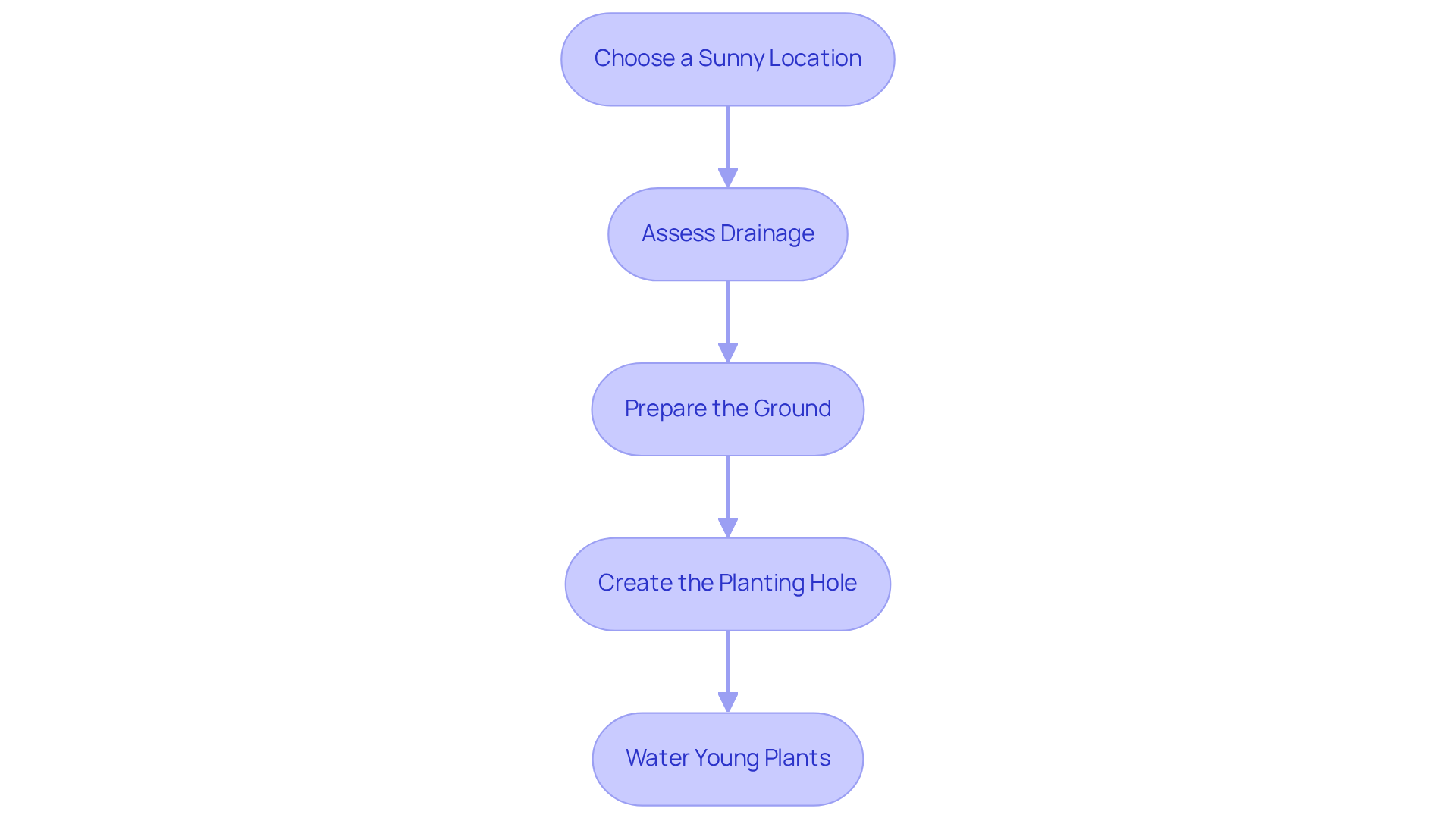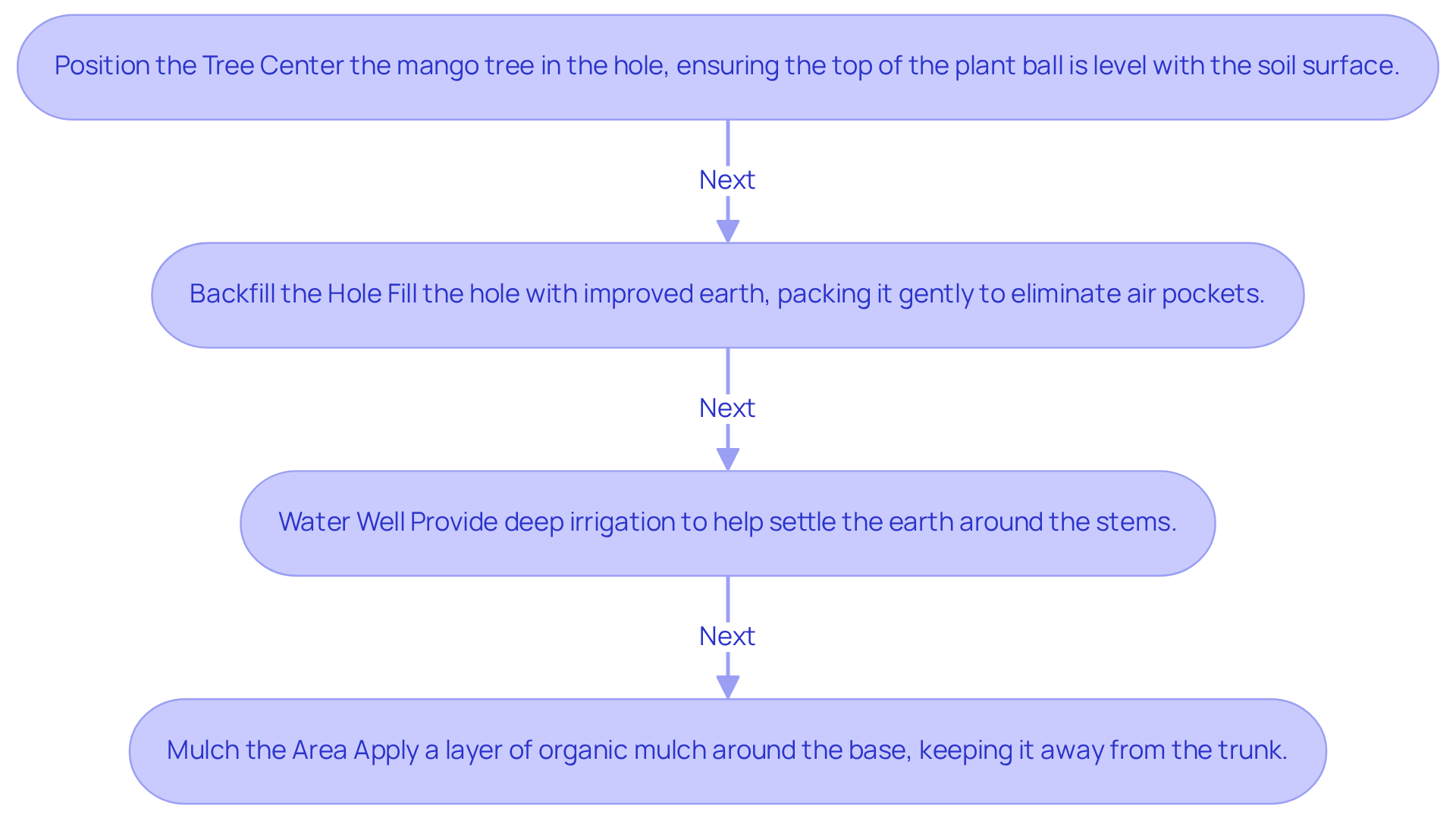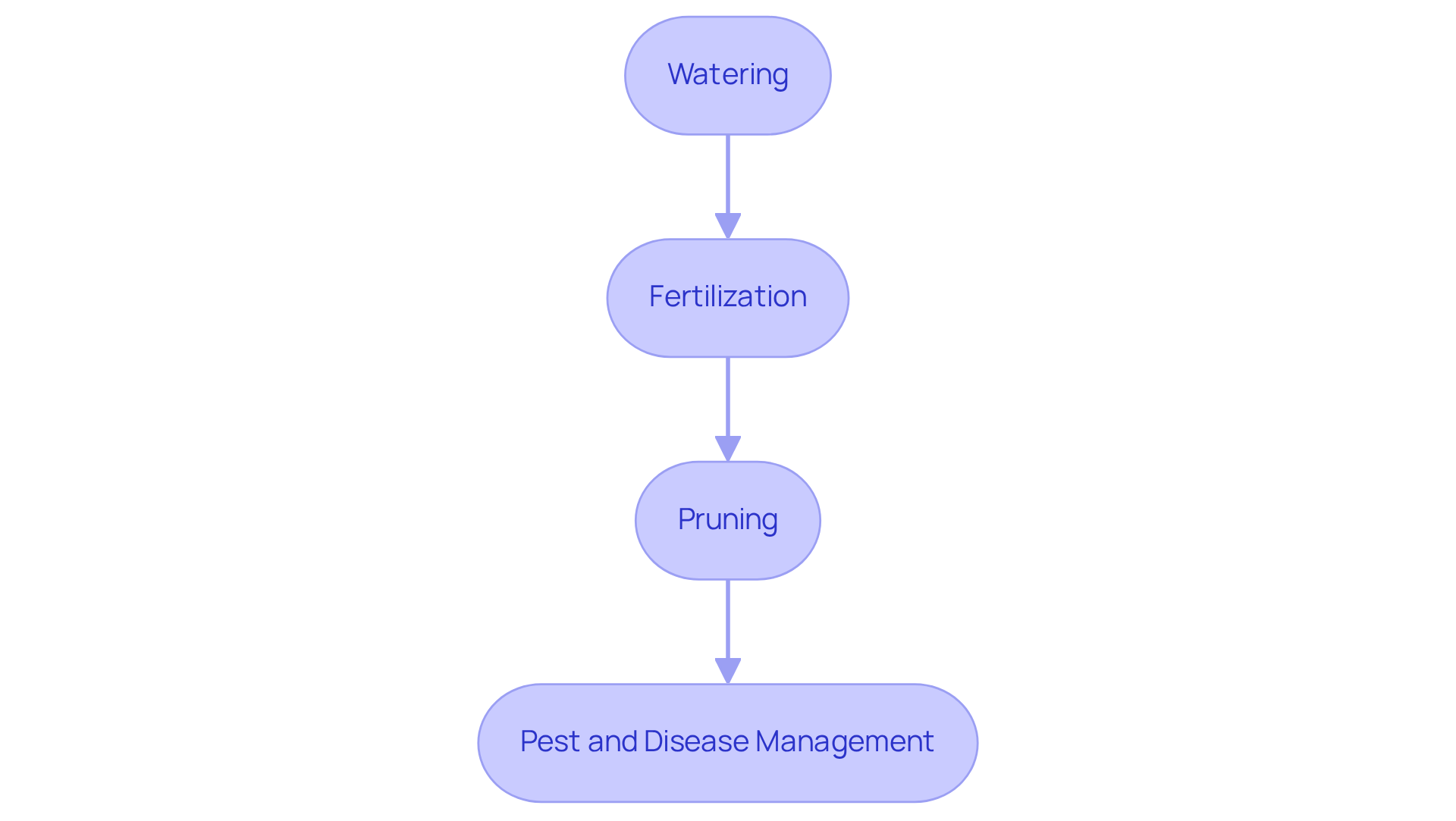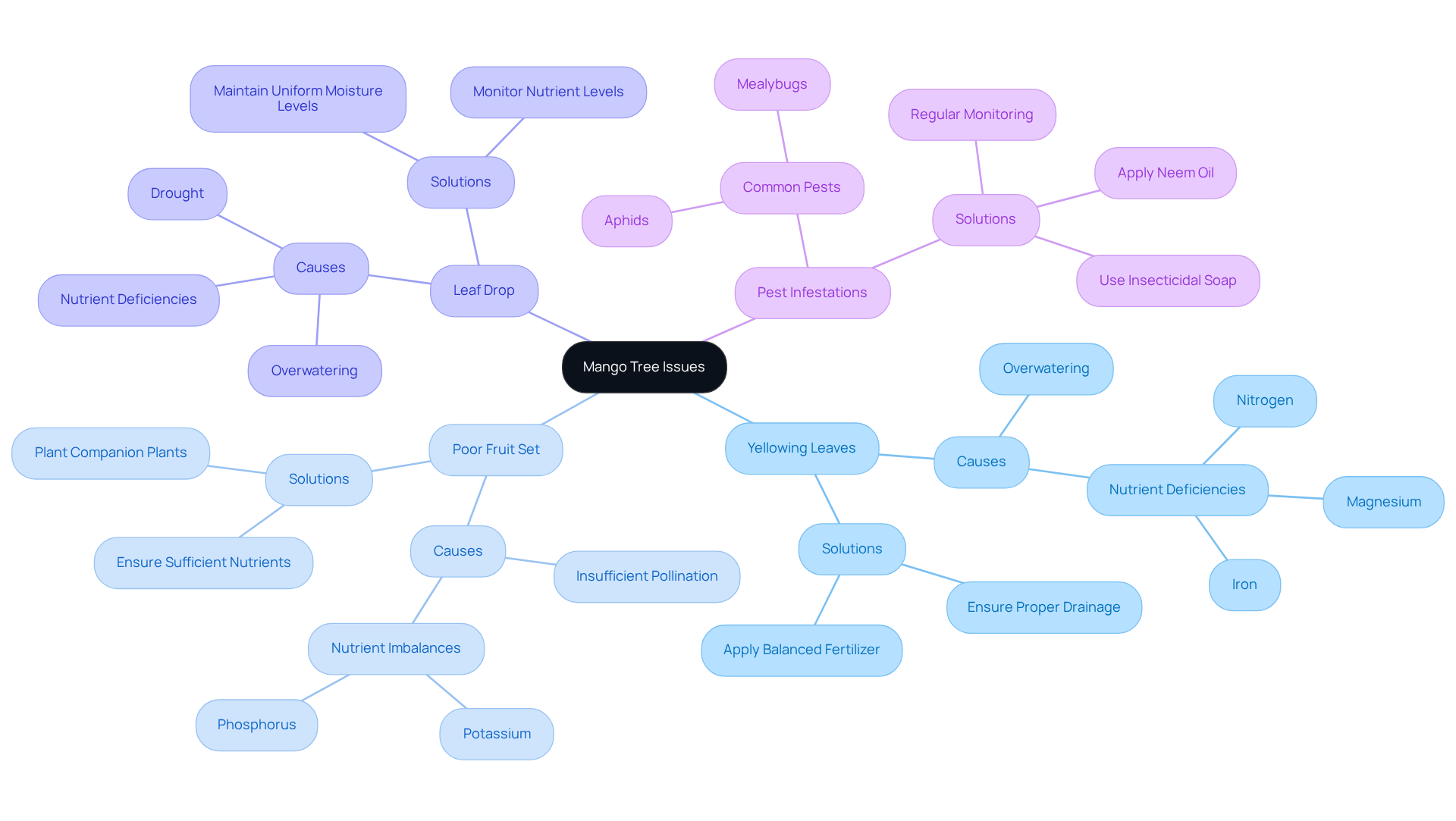Selecting the right site and nurturing a Mallika mango tree can transform a garden into a tropical paradise, abundant with sweet, succulent fruit. This guide outlines essential steps to ensure successful growth, from choosing the perfect location to mastering ongoing care.
However, what occurs when the tree begins to exhibit signs of distress or fails to produce fruit? Understanding the intricacies of mango cultivation is crucial for overcoming these challenges and ultimately reaping the rewards of a thriving mango tree.
Thinking about growing a mango tree at your garden?
Consider Mallika Mango Tree at Everglades Farm - shipped directly from Florida.
1. Select the Ideal Site and Prepare the Soil
-
Choose a Sunny Location: Selecting a site that receives at least 6-8 hours of direct sunlight daily is crucial. Mallika mango trees thrive in warm climates and require ample sunlight for optimal growth and fruit production.
-
Assess Drainage: It's essential to ensure that the area has excellent drainage to prevent waterlogging, which can lead to root rot. Avoid low-lying regions where water tends to accumulate, as adequate drainage is vital for the health of fruit-bearing plants.
-
Prepare the Ground: Begin by checking the pH level, as mango plants prefer slightly acidic to neutral soil, ideally between 5.5 and 7.5. The best soil type for the mallika mango tree is well-draining sandy loam. To enhance fertility and drainage, improve the ground by mixing in organic materials such as compost or well-decomposed manure. Additionally, consider incorporating treatments like Zinc sulphate, Copper sulphate, and Boric acid to boost fruit yield. Aim for a loose, well-draining soil mix that retains moisture without becoming soggy, as this is crucial for healthy plant growth.
-
Create the Planting Hole: Dig a hole that is twice as wide and deep as the root ball of the plant. This allows the roots to extend easily and establishes a solid base for the plant, promoting robust growth. Ensure to space fruit plants 12 to 15 feet apart to facilitate proper air circulation and prevent overcrowding. For young fruit plants, water them approximately twice a week to maintain adequate moisture without overwatering.

2. Plant the Mallika Mango Tree Correctly
-
Position the Tree: Center the mango tree in the prepared hole, ensuring that the top of the plant ball is level with the surrounding soil surface. This placement prevents water from accumulating around the trunk, which can lead to root decay. Ideally, the depth for the soil ball should be approximately ½ to 1 inch above ground level to promote healthy growth. Like soursop trees, proper placement of the mallika mango tree is crucial for ensuring optimal drainage and plant development.
-
Backfill the Hole: Carefully fill the hole with improved earth, gently packing it down to eliminate air pockets. It is essential to avoid packing the ground too firmly, as this can hinder plant growth and development. Horticulturists emphasize that proper backfilling techniques are vital for establishing a strong foundation for the tree, similar to the practices recommended for soursop cultivation.
-
Water Well: After planting, provide deep irrigation to help settle the earth around the stems. This initial watering is critical for forming a strong connection between the plants and the ground, fostering robust growth. Ensure that the soil for the mallika mango tree remains damp but not overly saturated, as this is a common practice for both mango and soursop plants to encourage strong root systems.
-
Mulch the Area: Apply a layer of organic mulch around the base of the plant, keeping it a few inches away from the trunk. Mulch retains moisture, suppresses weeds, and helps regulate soil temperature, creating an ideal environment for plant growth. Optimal soil conditions for the fruit consist of well-draining sandy loam with a slightly acidic to neutral pH (5.5 to 7.5), similar to the requirements for soursop plants.

3. Maintain and Care for Your Mango Tree
-
Watering: Regular watering is crucial, particularly during dry spells. For young Mallika mango trees, deep watering once a week is advised. Once established, these plants demonstrate drought tolerance but still require consistent moisture during the fruit development phase. Efficient watering plans should consider the plant's growth stage, with peak evapotranspiration rates reaching 5-6 mm per day in ideal conditions, ensuring optimal hydration for healthy growth.
-
Fertilization: To encourage healthy growth and fruit production, utilize a balanced fertilizer specifically designed for fruit plants. The ideal fertilization schedule includes an application in early spring followed by a second round in mid-summer. Adhere to the manufacturer's dosage guidelines, adjusting as necessary based on the age and size of the plant. Professional-grade fertilizers can significantly enhance growth and yield, ensuring the plant receives essential nutrients throughout its development, ultimately leading to a more fruitful harvest.
-
Pruning: Annual trimming is essential for maintaining the health of your mango plant. This practice involves eliminating dead or unhealthy branches and contouring the plant to enhance air circulation and light access. Proper pruning not only aids in disease prevention but also promotes vigorous growth, enabling the plant to flourish in its surroundings and maximizing its fruiting potential.
-
Pest and Disease Management: Regular checks for pests and diseases are vital for the wellbeing of your fruit plant. Common issues include anthracnose and weevils that affect mangoes. Employ organic pest control methods or fungicides as necessary, following recommended guidelines to effectively manage these threats. For instance, using neem oil can be an effective organic solution against pests. Additionally, consider best practices from soursop cultivation, such as maintaining proper spacing and ensuring good drainage, which can also help mitigate pest issues. By integrating these practices, you can enhance the overall health and productivity of your Mallika mango tree.

4. Troubleshoot Common Mango Tree Issues
-
Yellowing Leaves: This symptom often signals overwatering or nutrient deficiencies. To address this, ensure the soil has proper drainage and consider applying a balanced fertilizer to replenish any depleted nutrients. Common deficiencies that may cause yellowing include nitrogen, magnesium, and iron. For instance, nitrogen deficiency can lead to pale green or yellow leaves and stunted growth, ultimately affecting the overall health of the plant.
-
Poor Fruit Set: If your plant produces flowers but does not develop fruit, it may be due to insufficient pollination or nutrient imbalances. Ensure that the plant receives sufficient nutrients, particularly potassium and phosphorus, which are essential for fruit development. Additionally, consider planting companion plants to attract pollinators, thereby enhancing fruit set and promoting a more fruitful harvest.
-
Leaf Drop: Excessive leaf drop can result from stress caused by drought or overwatering. Consistently observe your watering methods and modify them to sustain uniform moisture levels, which encourages stability and health of plants. Furthermore, ensure that the plant is not suffering from nutrient deficiencies, as this can also contribute to leaf drop and hinder growth.
-
Pest Infestations: Common pests like aphids and mealybugs can endanger the health of your mango plant. Address infestations promptly using insecticidal soap or neem oil, ensuring thorough coverage of all affected areas to protect your tree. Regular monitoring for pests can help prevent severe infestations, safeguarding the vitality of your plants.
For more tailored solutions, consider consulting local agricultural extension services, which can provide specific advice based on your region's conditions.

Conclusion
Successfully growing a Mallika mango tree requires careful consideration of several factors, including site selection, soil preparation, planting techniques, and ongoing maintenance. By adhering to the outlined steps—starting with selecting a sunny location with excellent drainage and implementing a robust care routine—one can ensure that the tree thrives and produces delicious fruit.
Key points discussed encompass the significance of:
- Preparing well-draining soil
- Maintaining the proper planting depth
- Ensuring regular watering and fertilization
Furthermore, understanding how to troubleshoot common issues, such as yellowing leaves and poor fruit set, is essential for sustaining the tree's health. By integrating these best practices, gardeners can significantly enhance the growth potential and fruit yield of their Mallika mango trees.
Ultimately, cultivating a Mallika mango tree transcends mere planting and watering; it involves fostering a thriving ecosystem that supports the tree's development. With diligence and care, anyone can reap the sweet rewards of their labor. Embrace the journey of growing this exquisite fruit tree and take the necessary steps to ensure its success in your garden.
Grow Your Own Mallika Mango Tree Today!
Start your gardening journey with Everglades Farm and enjoy delicious fruit right from your backyard.
Frequently Asked Questions
What is the ideal location for planting Mallika mango trees?
The ideal location for planting Mallika mango trees is a sunny site that receives at least 6-8 hours of direct sunlight daily.
Why is drainage important for planting mango trees?
Drainage is important because it prevents waterlogging, which can lead to root rot. It is advisable to avoid low-lying areas where water tends to accumulate.
What soil conditions are best for Mallika mango trees?
Mallika mango trees prefer slightly acidic to neutral soil with a pH level between 5.5 and 7.5. The best soil type is well-draining sandy loam.
How can I improve the soil for planting mango trees?
You can improve the soil by mixing in organic materials such as compost or well-decomposed manure. Additionally, incorporating treatments like Zinc sulphate, Copper sulphate, and Boric acid can boost fruit yield.
How should I prepare the planting hole for a mango tree?
The planting hole should be dug twice as wide and deep as the root ball of the plant to allow the roots to extend easily and establish a solid base for robust growth.
What is the recommended spacing for planting mango trees?
It is recommended to space fruit plants 12 to 15 feet apart to facilitate proper air circulation and prevent overcrowding.
How often should young mango plants be watered?
Young mango plants should be watered approximately twice a week to maintain adequate moisture without overwatering.





0 comments